All about the Canadian well
Cooling your home without necessarily using air conditioning? Conversely, in winter, how to have quality indoor air without cooling your home? Discover this article that will easily explain what a Canadian well is.
How a Canadian well works
The Canadian well, also known as the Provençal well or climatic well, is a so-called surface geothermal system.
The operating principle of the climatic well is simple: outside air is circulated through tubes buried at a depth where the ground temperature varies little: the outside temperature can range from -15° to +40° in France, while that of the ground is stable overall, whatever the season (+-12 to 14°).
The tubes are positioned at a depth of about 1.5 to 2 metres.
As an integral part of a building's heating/cooling strategy, the climatic well must be integrated into the construction or renovation project from the design stage. Its effectiveness is directly linked to an overall approach to the building's energy performance (insulation, solar gain, bioclimatism).
Note that there are also "Canadian water wells"
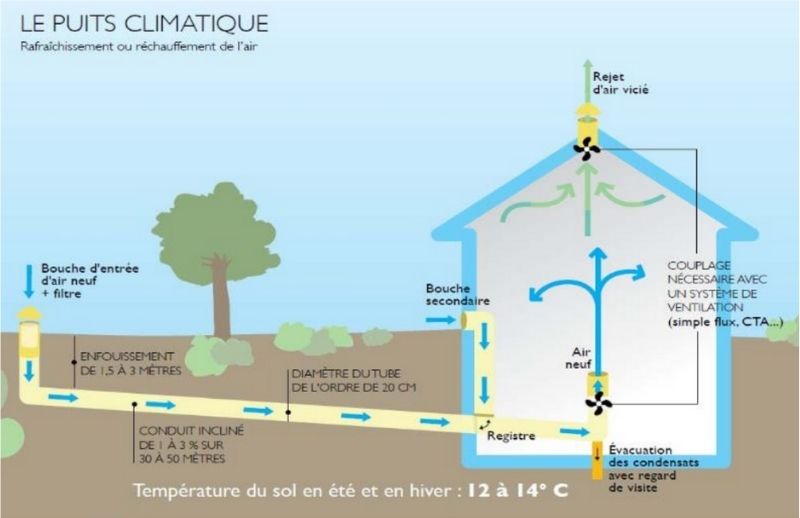
Source: Ademe
In contact with the ground, the air exchanges its calories and enters the home through a ventilation system, most often a double flow. In winter, the air will therefore warm up in contact with the ground and will always be at least above 0°. Conversely, in summer, the coolness of the ground will be used to cool the outside air before it enters the house. This is an element found in the bioclimatic design of a house.
The different types of Canadian wells
The Canadian air-source heat pump
The Canadian air well is the most common system. The network is installed on a slope to evacuate the condensates. The duct is usually 200 mm in diameter for a single-family home.
In most cases, the fan of the double flow CMV which is coupled to the system is sufficient to draw in the necessary amount of fresh air. Note that the Canadian air well is sensitive to the presence of radon, the watertightness of the buried network must be perfect in the regions concerned.
Composition of the Canadian air well

- An air intake vent, with a grille (to block insects, leaves, mice) and a G3 or G4 type filter: it pre-filters the outside air before entering the circuit.
- Underground ducts: pipes and ducts for the passage of air with a slope greater than 2%. They must be of "food" quality for a Canadian air well: they allow the evacuation of condensates and thus avoid the risks of mould and residual humidity.
Their internal structure is smooth. They must be made of a material that does not emit solvents or Volatile Organic Compounds (VOCs). Their rigidity must also be such that they can withstand the stresses of the ground. - A condensate collection device with a siphon,
- A CMV, ideally high-efficiency double flow. The combination of this ventilation with the Canadian well is the best solution for the distribution of air between the different rooms and the balancing between the quantity of air blown in and the quantity of air drawn in.
- A manhole to check your installation and clean it if necessary.
- A bypass: in mid-season, with mild temperatures, you can take in outside air directly to bypass the Canadian well. The bypass is triggered directly by an outdoor thermal sensor or manually. Nevertheless, a light air flow will always be sent in the ducts to avoid the proliferation of odours and bacteria (about 10%)
The hydraulic Canadian well
The hydraulic Canadian well is also known as a water Canadian well, or brine Canadian well in regions where the risk of ground freezing exists, is very different from its air counterpart. First of all, the duct does not need to be sloped, there is no risk of condensate or radon problems.
The length of the underground duct is generally longer than an air-source heat pump, but the diameter of the tube is generally 5 times smaller (water exchanges 4 times better than air).
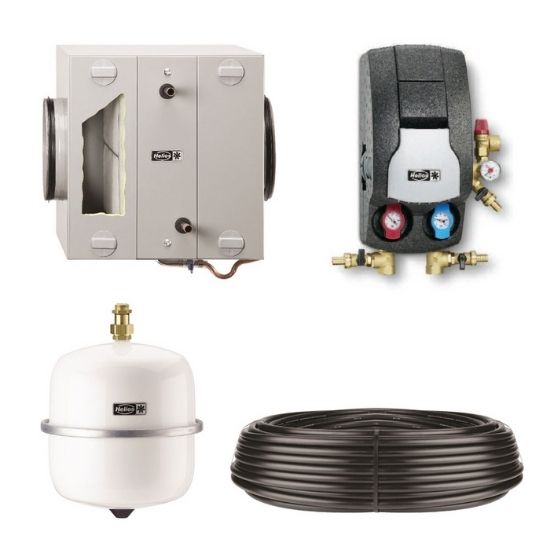
However, a water circulator is required which induces additional electrical consumption. In addition, an exchanger must be added between the new air to be preheated and the water (glycol). Finally, the hydraulic kits, with the same options (no need for a bypass), are generally less expensive.
The 5 advantages of the Canadian well
Ecological
The Canadian well is a natural way to regulate the temperatures of one's home. It relies on energy that is renewed every season and is inexhaustible. Moreover, in the case of the air version, it does not use refrigerants. All that is done is to recover the energy that is located several metres underground.
Low consumption
A Canadian Well requires little electricity to recover the calories.The coefficient of performance (COP) of a Canadian Well varies by a factor of 10 to 20 depending on the quality of the models. Quite simply, this means that for every Watt consumed, the Canadian well will give back up to 20. To compare, the COP of an air conditioning system is 2 to 4.
Moreover, the use of a Canadian well avoids the use of a defroster within your CMV: the outside air has already been heated before arriving in your central CMV.
The savings achieved vary according to your region, or more precisely the climate of your region: the greatest gains are obtained when the temperature differential between the ground and the outside air is significant (over 10°).
Heating + air conditioning
Less heating in winter, refreshed air in summer: energy savings can range from 10% to 20% in a well-designed home.
To give you a concrete case, we carried out a test at a self-builder client's home. With an outside temperature close to 30°, the air at the outlet of the CMV exchanger was close to 20°, with a few degrees of difference depending on the desired airflow. The test was carried out on 17 June 2021 in the Ain.
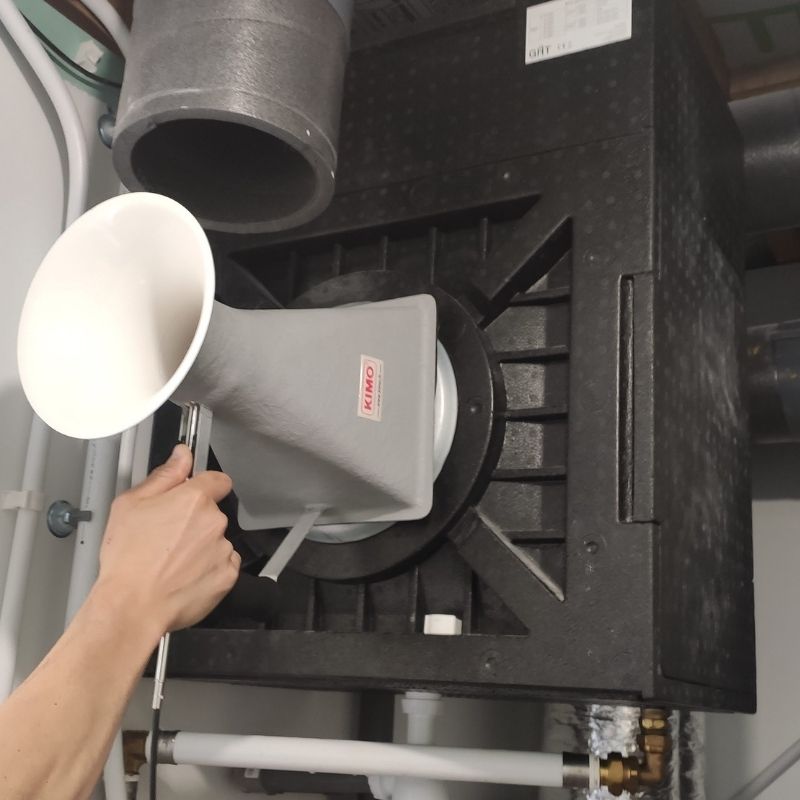
These calories and frigories are stored in the ground, which is in fact an energy reservoir that is renewed each season. The Canadian well allows a temperature delta of about 10 degrees between the outside temperature and the temperature of the air leaving the Canadian well.

It was 31° that day (17 June 2021).
Silent and unobtrusive
Unlike air conditioning, this solution does not make noise and does not require a fan unit outside. Only the air intake will be visible.
Easy to use
The control is directly automated at the central unit of your controlled mechanical ventilation.
The disadvantages of the Canadian well
Start-up investment
The initial budget is not neutral: equipment, work to be done in the house, the earthwork. Ideally, it is preferable to install this system as soon as the house is built or during a complete renovation.
However, with the explosion in the cost of electricity, you make the choice of a more autonomous solution with respect to these variations.
Maintenance of the network
As the ducts are located more than a metre underground, access to them is not always easy. Pests can sometimes enter the pipes despite the screens and filters.
Skill for successful installation
The installation of a Canadian well requires compliance with specific rules: declination of for a Canadian air well, sealing, nature of materials. To achieve good energy performance, it is advisable to call in a professional, both for the design and the start-up.
For the Canadian air well, it is essential that the continuous slope percentage of 1 to 3% is respected. If this is not the case, you run the risk of stagnant humidity, premature degradation of your pipes and radon gas emanations.
The price of a Canadian well
To get a complete picture, let's take the different elements in a table:
| Elements | Average air price |
|---|---|
| Canadian well kit (hardware only) |
1500€ to 4500€ |
| Gravelling and laying of buried ducts: Varies according to access and configuration of your land |
1500€ to 3000€ |
| CMV Double flow (hardware only) | 4500€ to 6000€ |
| Study, accompaniment, installation and start-up by a pro | €2500 to €3500 |
| Total: Canadian well + high-efficiency double flow CMV | €10,000 to €17,000 |
We advise you to select a recognised professional for this type of work, ideally RGE certified. Obviously, ask for a precise technical study or possibly approach a thermal engineer who will be able to direct you towards a quality craftsman.
At this rate, you will have the regulatory, robust and health risk-free equipment. Also remember, in order to properly choose your double flow CMV, to take into account the maintenance costs (cost of filters in particular), the noise level, the dimensions, etc.
The economics of a Canadian well
It is difficult to give a factual answer to this question. Depending on the quality of your house's insulation, its location, the altitude, the data changes fundamentally.
Yet, it should be taken into account that it can save you the installation of air conditioning. Moreover, the Canadian well meets a comfort requirement with increasingly regular heat waves.
The main brands that offer Canadian wells
The ventilation specialists will be found very naturally:
- Brink Climate Systems
- Helios
- Zendher
The list is not exhaustive, you will find other manufacturers on the market. Note that Aldes does not distribute this type of product: you simply need to couple your CMV of this brand with a Canadian well selected elsewhere.
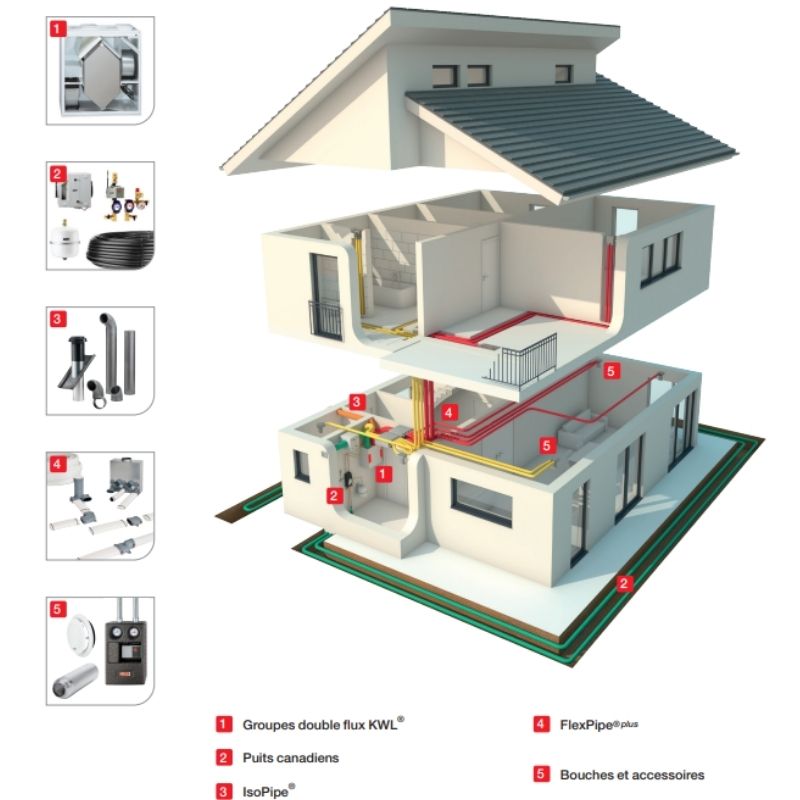
Example of a complete configuration from the manufacturer HELIOS.
Our opinion on the Canadian well
I have the same one at home. It's a low-tech technology, more environmentally friendly than air conditioning. In areas affected by radon, we recommend the hydraulic Canadian well.
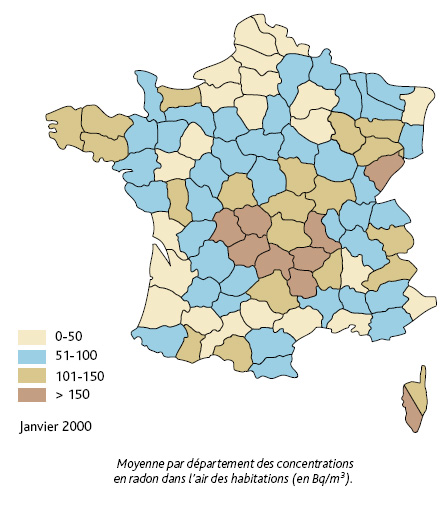
To find out the precise concentration level in your commune, it's very simple, go to the site of the Institut de Radioprotection et Sûreté Nucléaire (IRSN).
In new house projects or for global renovations, this solution deserves to be studied and costed, especially with the evolution of temperatures. It provides a natural response to a level of comfort while allowing for energy savings.
We invite you to pay close attention to the respect of the installation rules because the biggest risk would be to degrade the quality of the air without realising it: unsuitable materials that generate VOCs, radon, humidity and mould, etc.
Be careful not to focus solely on the temperature blown into your home, a poor quality installation will directly impact your health, without you being able to see it on a daily basis. Feel free to find all our articles related to ventilation and air quality.
